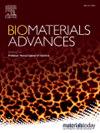Modifying the antibacterial performance of Cu surfaces by topographic patterning in the micro- and nanometer scale
IF 5.5
2区 医学
Q2 MATERIALS SCIENCE, BIOMATERIALS
Materials Science & Engineering C-Materials for Biological Applications
Pub Date : 2025-01-10
DOI:10.1016/j.bioadv.2025.214184
引用次数: 0
Abstract
Antimicrobial surfaces are a promising approach to reduce the spread of pathogenic microorganisms in various critical environments. To achieve high antimicrobial functionality, it is essential to consider the material-specific bactericidal mode of action in conjunction with bacterial surface interactions. This study investigates the effect of altered contact conditions on the antimicrobial efficiency of Cu surfaces against Escherichia coli and Staphylococcus aureus. The fabrication of line-like periodic surface patterns in the scale range of single bacterial cells was achieved utilizing ultrashort pulsed direct laser interference patterning. These patterns create both favorable and unfavorable topographies for bacterial adhesion. The variation in bacteria/surface interaction is monitored in terms of strain-specific bactericidal efficiency and the role of corrosive forces driving quantitative Cu ion release. The investigation revealed that bacterial deactivation on Cu surfaces can be either enhanced or decreased by intentional topography modifications, independent of Cu ion emission, with strain-specific deviations in effective pattern scales observed. The results of this study indicate the potential of targeted topographic surface functionalization to optimize antimicrobial surface designs, enabling strain-specific decontamination strategies.
在微纳米尺度上用形貌图修饰铜表面的抗菌性能。
抗菌表面是在各种关键环境中减少病原微生物传播的一种很有前途的方法。为了实现高抗菌功能,必须考虑与细菌表面相互作用相结合的材料特异性杀菌模式。本研究考察了不同接触条件对铜表面对大肠杆菌和金黄色葡萄球菌抗菌效果的影响。利用超短脉冲激光直接干涉制图技术,在单个细菌细胞的尺度范围内制备了线状周期性表面图案。这些模式为细菌粘附创造了有利和不利的地形。细菌/表面相互作用的变化是根据菌株特异性杀菌效率和腐蚀力驱动定量Cu离子释放的作用来监测的。研究表明,Cu表面的细菌失活可以通过有意的地形修饰来增强或减弱,而不依赖于Cu离子的发射,并且在有效模式尺度上观察到菌株特异性偏差。这项研究的结果表明,目标地形表面功能化的潜力,以优化抗菌表面设计,实现菌株特异性去污策略。
本文章由计算机程序翻译,如有差异,请以英文原文为准。
求助全文
约1分钟内获得全文
求助全文
来源期刊
CiteScore
17.80
自引率
0.00%
发文量
501
审稿时长
27 days
期刊介绍:
Biomaterials Advances, previously known as Materials Science and Engineering: C-Materials for Biological Applications (P-ISSN: 0928-4931, E-ISSN: 1873-0191). Includes topics at the interface of the biomedical sciences and materials engineering. These topics include:
• Bioinspired and biomimetic materials for medical applications
• Materials of biological origin for medical applications
• Materials for "active" medical applications
• Self-assembling and self-healing materials for medical applications
• "Smart" (i.e., stimulus-response) materials for medical applications
• Ceramic, metallic, polymeric, and composite materials for medical applications
• Materials for in vivo sensing
• Materials for in vivo imaging
• Materials for delivery of pharmacologic agents and vaccines
• Novel approaches for characterizing and modeling materials for medical applications
Manuscripts on biological topics without a materials science component, or manuscripts on materials science without biological applications, will not be considered for publication in Materials Science and Engineering C. New submissions are first assessed for language, scope and originality (plagiarism check) and can be desk rejected before review if they need English language improvements, are out of scope or present excessive duplication with published sources.
Biomaterials Advances sits within Elsevier''s biomaterials science portfolio alongside Biomaterials, Materials Today Bio and Biomaterials and Biosystems. As part of the broader Materials Today family, Biomaterials Advances offers authors rigorous peer review, rapid decisions, and high visibility. We look forward to receiving your submissions!

 求助内容:
求助内容: 应助结果提醒方式:
应助结果提醒方式:


